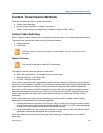
Sharing Content During Conferences
Polycom®, Inc. 139
Guidelines for Sending Content to Legacy Endpoints
● A separate HD video resource is allocated to the conference for content sending to legacy endpoints.
Allocation is performed only once a legacy content endpoint is connected to the conference, and a
content session is initiated and transmitted via the people video layout. Once the resource is
allocated, it remains allocated to the conference until its end.
If the system cannot allocate the resource required for sending the content, the conference status
changes to Content Resource Deficiency, and content cannot be sent to the legacy endpoints.
● Endpoints receiving content via the people video layout, use the same video protocol and resolution
they use for receiving video.
● Content cannot be sent to Legacy endpoints when Same Layout mode is selected for the conference.
● This option in not supported in Video Switching conferences.
● Content can be sent to Legacy endpoints in gateway calls, depending on content configuration on
Master/Slave MCUs (for example, if the gateway conference is using H.263 content media protocol,
and the conference MCU is using H.264 content media protocol).
● FX endpoints dialing into the MCU, share content via the content channel (People+Content), whereas
FX endpoints dialing out to the MCU, view content via the people video layout.
Content Display on Legacy Endpoints
When content is sent to content legacy endpoints, their video layout automatically changes to the content
layout defined by the system flag LEGACY_EP_CONTENT_DEFAULT_LAYOUT (default layout is -
CP_LAYOUT_1P4VER), and the content is shown in the larger/top-left cell. The video layouts of the other
conference participants do not change. (To modify the default layout, see
LEGACY_EP_CONTENT_DEFAULT_LAYOUT Flag.)
The switch to the content layout occurs in Auto Layout, Presentation Mode, Lecture Mode, and when a
layout is selected for the conference.
In Lecture Mode, when content is sent to legacy endpoints, switching to the content layout, results in the
content shown in the lecturer/speaker window, while the lecturer is shown in the second window. If the layout
contains more than two windows, all other windows are empty. The non-lecturer legacy content participants
see the lecturer in full screen.
When content is stopped, the layout of the legacy participants terminates as well.
Legacy participants can change their layout using Click&View. In such a case, the content is forced to the
larger/top-left cell.
The Collaboration Server user can also change the layout for the legacy content endpoints participants
(selecting personal layout).
When forcing a video participant to the Content window (instead of Content), the Content display can be
restored only by selecting any other video layout.
Sending Content to Legacy Endpoints in Telepresence Mode
To ignore personal layouts during Telepresence conferences (while working with MLA), set the value of the
flag FORCE_LEGACY_EP_CONTENT_LAYOUT_ON_TELEPRESENCE to YES.
If the layout for displaying content in Legacy endpoints include multiples cells, MCU may populate
Telepresence room streams sources in remote cells.


















